신생아의 눈, Eyes of newborn infants
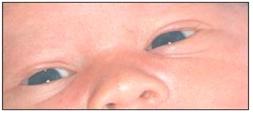
사진 2-140. 신생아의 정상 눈
Copyright ⓒ 2011 John Sangwon Lee, MD., FAAP
- 태어나서부터 생후 1~2개월까지 대부분의 신생아들은 1일 18~20시간 정도 잠자는 것이 보통이다. (참고로, 연구에 따라 1일 15~20시간 동안 자기도 한다.)
- 어떤 갓난아기는 태어난 첫날부터 한 달이 다 된 아기들처럼 눈을 말똥말똥 뜨고 주위를 둘러보기도 한다.
- 신생아들이 울 때 눈물샘에서 눈물이 항시 어느 정도 흘러나오지만 뺨으로 흘러내릴 정도로 많이 흘러나오지는 않는다.
- 갓 태어난 신생아의 눈은 불빛에 예민하게 반응한다.
- 신생아의 눈에 전등 불빛을 직접 비치면 양 눈을 꼭 감는 것이 보통이다.
- 소아들이나 성인들의 정상 시력은 20/20이다.
- 갓 태어난 신생아의 정상 시력은 20/600 정도이다.
- 신생아는 엄마 아빠의 얼굴이나 그와 같이 비교적 큰 물체를 잘 볼 수 있다.
- 생후 4∼5주 후 코나 눈의 크기와 같이 작은 물체도 잘 볼 수 있다.
- 엄마 아빠가 한 자리에서 다른 자리로 움직이는 엄마 아빠들에 따라 자기의 얼굴을 어느 정도 돌리고 볼 수 있다.
- 임질균 질염을 앓거나 임질균을 보균하고 있는 모체에게 태어난 신생아는 엄마의 질 산도 속에 있던 임질균에 감염되어 신생아 임질균 결막염에 걸릴 수 있다.
- 이런 신생아 임질균 결막염을 예방하기 위해 갓 태어난 신생아들의 눈에 에리스로마이신(Erythromycin) 안연고나 테라마이신(Terramycin) 안연고를 통상적으로 발라 예방적 치료를 하는 것이 보통이다. p.000 신생아의 결막염 참조)
- 분만 중 산도에서 갓 태어난 신생아의 결막 하 모세혈관이 터져 결막 하에 피가 조금 맺힐 수 있다.
- 이 결막하 출혈은 생후 2주 내에 자연히 없어진다.
- 신생아들에게 진짜로 사시가 없는데도 사시가 있는 것처럼 안구가 한쪽으로 쏠릴 수 있다. 즉 가성사시 현상이 생길 수 있다.
- 부모도 반의사가 되어야한다-소아가정간호백과-제 19권 신생아 질환-시력검사, 신생아 결막 하 출혈, 결막 하 출혈 참조)
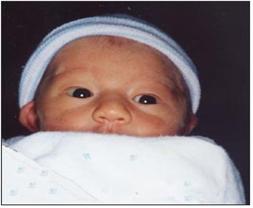
사진 2-141. 3일 된 신생아의 눈
Copyright ⓒ 2011 John Sangwon Lee, MD., FAAP

사진 2-142. 3일 된 신생아의 눈
Copyright ⓒ 2011 John Sangwon Lee, MD., FAAP
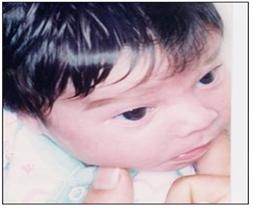
사진 2-143. 생후 1주 된 신생아의 눈
Copyright ⓒ 2011 John Sangwon Lee, MD., FAAP
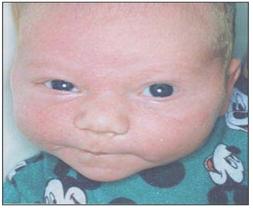
사진 2-144. 생후 3주 된 신생아의 눈
Copyright ⓒ 2011 John Sangwon Lee, MD., FAAP
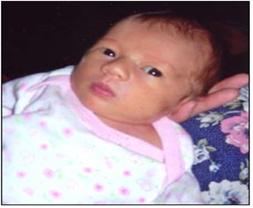
사진 2-145. 실제로 사시가 없는 신생아의 왼쪽 눈에 사시가 있는 것같이 보인다. 이런 현상을 가성사시라고 한다. Copyright ⓒ 2011 John Sangwon Lee, MD., FAAP
Eyes of newborn infants 신생아의 눈
Photo 2-140. Newborn’s normal eyes. Copyright ⓒ 2011 John Sangwon Lee, MD., FAAP
- From birth to 1 to 2 months of age, most newborns usually sleep 18 to 20 hours a day. (For reference, depending on the study, newborns sleep for 15 to 20 hours a day.)
- Some newborn babies look around with their eyes open like babies who are a month old from the first day they are born.
- When newborn babies cry, some tears always flow out of their lacrimal glands, but not so much that flow down their cheeks.
- Newborn babies’ eyes react sensitively to light. It is common to close both eyes tightly when a light is shining directly into the newborn’s eyes.
- Normal vision in children and adults is 20/20. The normal vision for a newborn baby is around 20/600.
- Newborns can see the faces of mothers and fathers and relatively large objects like that well. After 4-5 weeks of age, small objects such as the size of the nose or eyes can be seen well.
- Mom and Dad can turn and see her face to some extent according to her mom and dad moving from one place to another.
- Newborns born to a mother with gonorrhea can be infected with gonorrhea bacteria in the mother’s vaginal canal and develop neonatal gonococcal conjunctivitis.
- In order to prevent such neonatal gonorrhea conjunctivitis,
- it is common to apply erythromycin eye ointment or Terramycin eye ointment to the eyes of newborn infants for prophylactic treatment for neonatal conjunctivitis.
- During delivery, the subconjunctival capillaries of newborns born in the birth canal may burst, resulting in a little blood formation under the conjunctiva.
- This subconjunctival hemorrhage disappears spontaneously within 2 weeks of life. Even though newborns don’t really have a strabismus, the eyeball can be oriented to one side as if they had strabismus.
- In other words, false strabismus may occur.
- Parents should also be at least the half-doctors-Children and Family Nursing Encyclopedia-Volume 19 Newborn Diseases-Visual examination, neonatal subconjunctival hemorrhage, see subconjunctival hemorrhage)
Photo 2-141. Eyes of a 3-day-old newborn. Copyright ⓒ 2011 John Sangwon Lee, MD., FAAP
Photo 2-142. Eyes of a 3-day-old newborn. Copyright ⓒ 2011 John Sangwon Lee, MD., FAAP
Photo 2-143. Newborn’s eyes 1-week old, Copyright ⓒ 2011 John Sangwon Lee, MD., FAAP
Photo 2-144. 3 weeks old newborn’s eyes. Copyright ⓒ 2011 John Sangwon Lee, MD., FAAP
Photo 2-145. In fact, this newborn has no real strabismus but the left eye
appears to have the real strabismus. This phenomenon is called false strabismus. Copyright ⓒ 2011 John Sangwon Lee, MD., FAAP
출처 및 참조 문헌
- NelsonTextbook of Pediatrics 22ND Ed
- The Harriet Lane Handbook 22ND Ed
- Growth and development of the children
- Red Book 32nd Ed 2021-2024
- Neonatal Resuscitation, American Academy Pediatrics
- www.drleepediatrics.com 제1권 소아청소년 응급 의료
- www.drleepediatrics.com 제2권 소아청소년 예방
- www.drleepediatrics.com 제3권 소아청소년 성장 발육 육아
- www.drleepediatrics.com 제4권 모유,모유수유, 이유
- www.drleepediatrics.com 제5권 인공영양, 우유, 이유식, 비타민, 미네랄, 단백질, 탄수화물, 지방
- www.drleepediatrics.com 제6권 신생아 성장 발육 육아 질병
- www.drleepediatrics.com제7권 소아청소년 감염병
- www.drleepediatrics.com제8권 소아청소년 호흡기 질환
- www.drleepediatrics.com제9권 소아청소년 소화기 질환
- www.drleepediatrics.com제10권. 소아청소년 신장 비뇨 생식기 질환
- www.drleepediatrics.com제11권. 소아청소년 심장 혈관계 질환
- www.drleepediatrics.com제12권. 소아청소년 신경 정신 질환, 행동 수면 문제
- www.drleepediatrics.com제13권. 소아청소년 혈액, 림프, 종양 질환
- www.drleepediatrics.com제14권. 소아청소년 내분비, 유전, 염색체, 대사, 희귀병
- www.drleepediatrics.com제15권. 소아청소년 알레르기, 자가 면역질환
- www.drleepediatrics.com제16권. 소아청소년 정형외과 질환
- www.drleepediatrics.com제17권. 소아청소년 피부 질환
- www.drleepediatrics.com제18권. 소아청소년 이비인후(귀 코 인두 후두) 질환
- www.drleepediatrics.com제19권. 소아청소년 안과 (눈)질환
- www.drleepediatrics.com 제20권 소아청소년 이 (치아)질환
- www.drleepediatrics.com 제21권 소아청소년 가정 학교 간호
- www.drleepediatrics.com 제22권 아들 딸 이렇게 사랑해 키우세요
- www.drleepediatrics.com 제23권 사춘기 아이들의 성장 발육 질병
- www.drleepediatrics.com 제24권 소아청소년 성교육
- www.drleepediatrics.com 제25권 임신, 분만, 출산, 신생아 돌보기
- Red book 29th-31st edition 2021
- Nelson Text Book of Pediatrics 19th- 21st Edition
- The Johns Hopkins Hospital, The Harriet Lane Handbook, 22nd edition
- 응급환자관리 정담미디어
- Pediatric Nutritional Handbook American Academy of Pediatrics
- 소아가정간호백과–부모도 반의사가 되어야 한다, 이상원 저
- The pregnancy Bible. By Joan stone, MD. Keith Eddleman, MD
- Neonatology Jeffrey J. Pomerance, C. Joan Richardson
- Preparation for Birth. Beverly Savage and Dianna Smith
- 임신에서 신생아 돌보기까지. 이상원
- Breastfeeding. by Ruth Lawrence and Robert Lawrence
- Sources and references on Growth, Development, Cares, and Diseases of Newborn Infants
- Emergency Medical Service for Children, By Ross Lab. May 1989. p.10
- Emergency care, Harvey Grant and Robert Murray
- Emergency Care Transportation of Sick and Injured American Academy of Orthopaedic Surgeons
- Emergency Pediatrics A Guide to Ambulatory Care, Roger M. Barkin, Peter Rosen
- Quick Reference To Pediatric Emergencies, Delmer J. Pascoe, M.D., Moses Grossman, M.D. with 26 contributors
- Neonatal resuscitation Ameican academy of pediatrics
- Pediatric Nutritional Handbook American Academy of Pediatrics
- Pediatric Resuscitation Pediatric Clinics of North America, Stephen M. Schexnayder, M.D.
-
Pediatric Critical Care, Pediatric Clinics of North America, James P. Orlowski, M.D.
-
Preparation for Birth. Beverly Savage and Dianna Smith
-
Infectious disease of children, Saul Krugman, Samuel L Katz, Ann A.
- 제4권 모유, 모유수유, 이유 참조문헌 및 출처
- 제5권 인공영양, 우유, 이유, 비타민, 단백질, 지방 탄수 화물 참조문헌 및 출처
- 제6권 신생아 성장발육 양호 질병 참조문헌 및 출처
- 소아과학 대한교과서
|
Copyright ⓒ 2015 John Sangwon Lee, MD., FAAP 미국 소아과 전문의, 한국 소아청소년과 전문의 이상원 저 “부모도 반의사가 되어야 한다”-내용은 여러분들의 의사로부터 얻은 정보와 진료를 대신할 수 없습니다. The information contained in this publication should not be used as a substitute for the medical care and advice of your doctor. There may be variations in treatment that your doctor may recommend based on individual facts and circumstances. “Parental education is the best medicine.” |